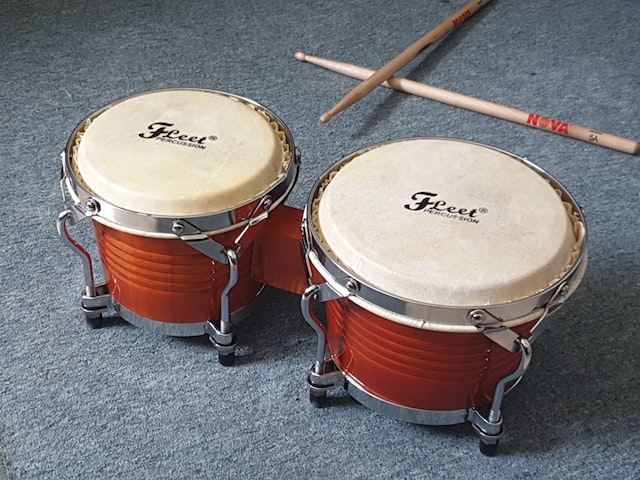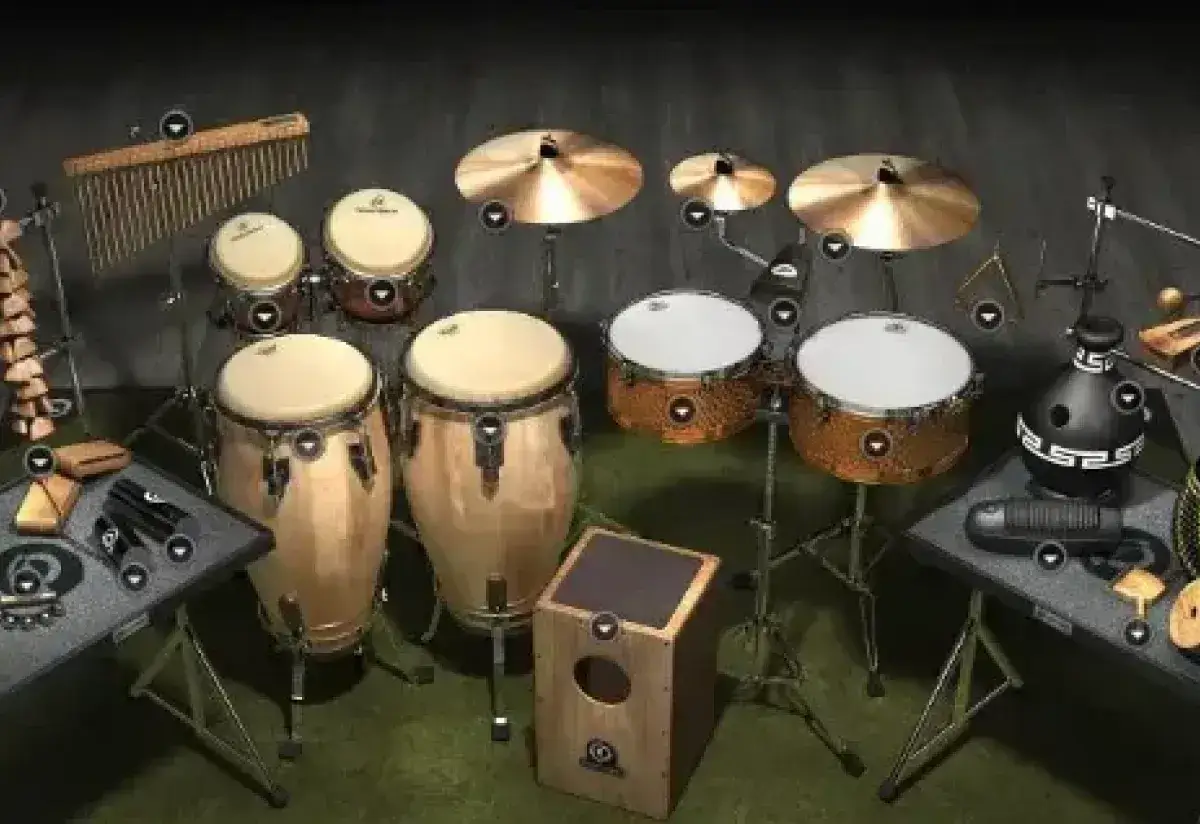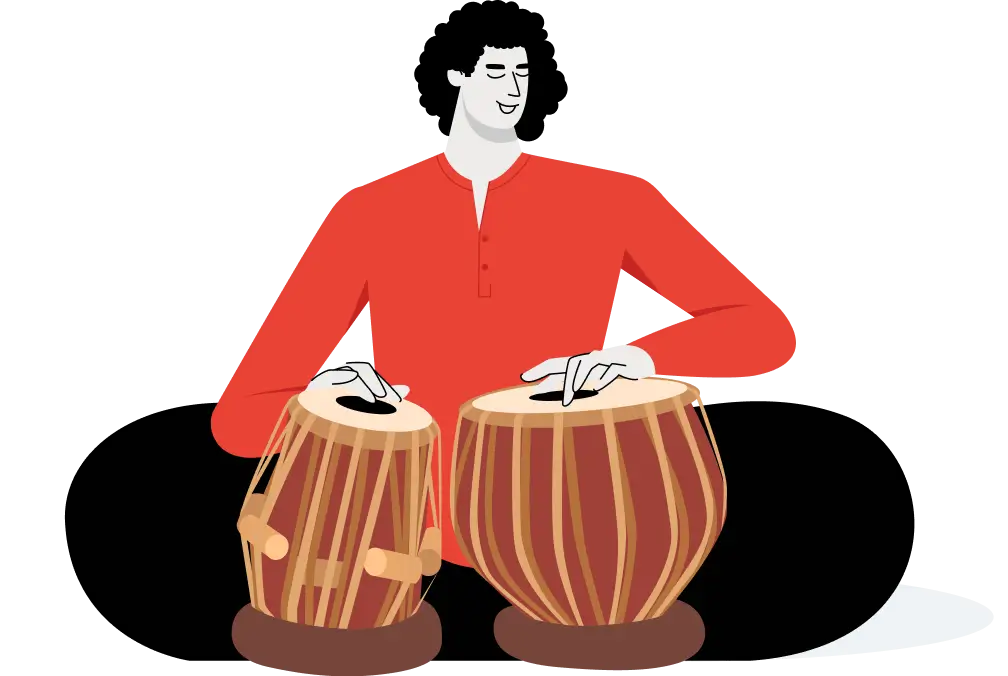Overview
The conga drum is the cornerstone of Latin rhythm and percussion and has become a popular instrument in many musical genres all over the world. Of Afro-Cuban origin, the conga is called the tumbadora in Cuba and the drummer is called a conguero. Congas are classified as both tubular hand drums and membranophones.
The conga is a tall, narrow, single-head drum that comes in a variety of pitches and sizes. The drums are typically played in sets of two or four, but unlike the bongos, conga drums are not usually joined by a bridge. Traditionally, they were made from olive barrels and staved wood but modern congas have a wooden or fiberglass shell that stands 75 cm high. Metal hardware secures the rawhide or synthetic skin to the head of the drum.

Traditional congas used the skin from a cow or mule for the head, which was tacked to the shell. This was the traditional technique for constructing African drums. Today’s congas still use skin from water buffalo and steer, in addition to synthetic skins. The conga shell is still made from steam-curved staved wood but the type of wood depends on the manufacturer’s preference. Some congas are still carved from a single piece of wood in the African drumming tradition.
The drums may be played while sitting, or standing by attaching them to a stand. The drum can also be strapped to the conguero’s shoulder for performances in parades or festivals. Conga drummers play a defined number of strokes with the fingers and palms of their bare hands. These strokes were popularized by mambo and conga music but the distinct tones can also be heard in jazz, reggae, folk, rock, classical, country, and samba music.
History of Congas
The conga drum has Afro-Cuban roots, the result of bringing thousands of slaves to Cuba from the Bantu-speaking Congo region of Africa during the 17th and 18th centuries. Around the time Cuban slavery ended in 1886, African drumming merged with Latin percussion, and the conga drum was born.
The conga’s Bantu predecessor was the makuta, a tall, barrel drum used in private religious ceremonies. The drum also has Nigerian roots in the bembé drum, a slightly smaller version of the conga that was traditionally used in festivals. The first conga drums were based on these traditional African drums and the famous conga style was introduced by the development of rumba music.
Rumba was the first genre to specifically call for tumbadoras and the style became massively popular at the beginning of the 20th century. During the 1930s, congas made a big impact on jazz music in the United States—leading to the origin of Salsa music. In the 1950s, the drums were modernized to include lugs and screws that would allow the player to precisely change the pitch of the drum head.
Originally, congueros would play only one drum at a time and there would be several congueros playing a rhythm together in a performance. As conga rhythms became more complex, drummers began playing multiple drums at one time. While the standard is two or four, there are some drummers who play five or more at a time.
Types of Congas
Congas come in three standard sizes and two specialty sizes. Between the different sizes, all dimensions and materials remain the same with the exception of the diameter of the drumhead. The smaller the drum head, the higher the pitch and vice versa. The congas can be played in any configuration or as a single drum. The three standard sizes are quinto (smallest), conga (middle), and tumba (largest).
The quinto has the highest pitch and a diameter of 28 cm. The quinto may be played as part of a melody or as an accent. The conga is 30 cm in diameter and produces a mid-range tone, a compliment to the small and large sizes. The tumba is nearly 32 cm in diameter and produces a deep, resonating bass tone. The tumba is perhaps the most popular and recognizable of all the sizes.
Two common specialty sizes include the smallest size, requinto and the largest size, supertumba, 25 and 35.5 cm respectively. These sizes are typically used when playing congas as the melody of a composition.
When buying a conga or taking conga lessons, it is important to know which conga drum you have, or will have. Any of the congas may be played solo but some are better suited for being played individually. The large tumba is a popular single drum for its deep, distinct tone.
Playing Techniques
Conga drum music typically includes five basic strokes.
- Bass tone (tono bajo) is made by striking the head of the drum with an open palm.
- Mute tone (tono ahogado) is made by striking the drum with four fingers while holding the base of those fingers against the head to muffle the tone.
- Open tone is made by striking the rim of the head with four fingers.
- Slap tone (tono seco) is made by curving the fingers slightly to strike the head, allowing the palm to strike the rim.
- Touch tone (toque de punta) is made by simply touching the palm, heel, or fingers to the drum.
There are many additional techniques for flourishes or different tones when playing the congas. Many conga players and teachers develop their own unique strokes, as well as variations on the standards. Below are some of the most common playing techniques.
- Heel-toe (manoteo) is made by alternately striking the center of the drumhead with palm and fingers.
- glissando is pitch bending. This stroke is done by rubbing the middle finger across the drum. It can also be done while applying pressure to the rim with the arm.
- Cascara refers to playing on the shell, or body, of the drum.
Mechanics
Traditionally, the conga drums were unpitched percussion instruments. Up until the 1950s, the drumheads were secured to the staved wood body by tacks or nails. In order to change the pitch, the skin was either moistened or heated (to evaporate the moisture). A moistened drumhead lowered the pitch, and being heated allowed the skin to vibrate faster, producing a higher pitch.
Early versions of the drum could also be tuned by adjusting tension knots or ropes attached to the skin of the drum. These methods were imprecise and were not used during a performance, only beforehand to achieve a desired tone. It wasn't until the 1950s that the congas were used as melody instruments.
Modern tuning was introduced to the congas by the famous Cuban conguero, Carlos Valdes. This tuning system involved using screws and lugs around the rim to tighten the drum head. Also known as 'Patato,' this 1950s New York City conga drummer enabled the congas to be played as harmonic instruments. It was Valdes' popularity that helped merge Latin percussion with American jazz.
The open tone is typically used to tune the conga. Although the exact pitch for each conga size depends heavily on how the conga was made and its size, there are standard guidelines. Generally, the open tone should ring out when played, the bass tone should resonate, and the slap tone should rise above the other sounds. Because there are lugs surrounding the rim, each screw must be tuned to match the others. This is checked by tapping near the rim of each lug to detect slight changes in tone. An electronic tuner or tuning app can also be used to tune the conga.
Notable musicians
There are many talented conga players, past and present. Below are some of the most well-known contemporary conga players from around the world.
- Alejandro Neciosup Acuña
- Armando Peraza
- Daniel de los Reyes
- Eilel Lazo
- Giovanni Hidalgo
- Janet Carlson
- José Luis Quintana
- Laudir de Oliveira
- Melena Francis Valdes
- Monojit Datta
- Orlando Vega Smith
- Peggy Nykamp
- Phillip Bailey
- Poncho Sánchez
- Sammy Figueroa
- Sheila Escovedo
- Taku Hirano
- Walfredo Reyes Jr.









